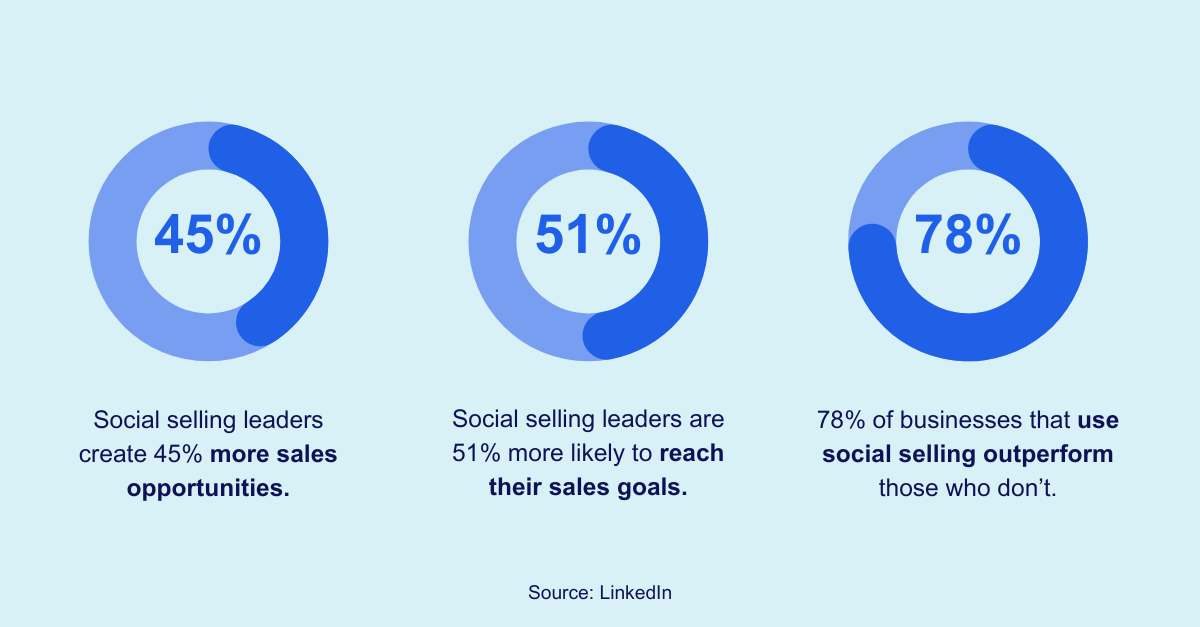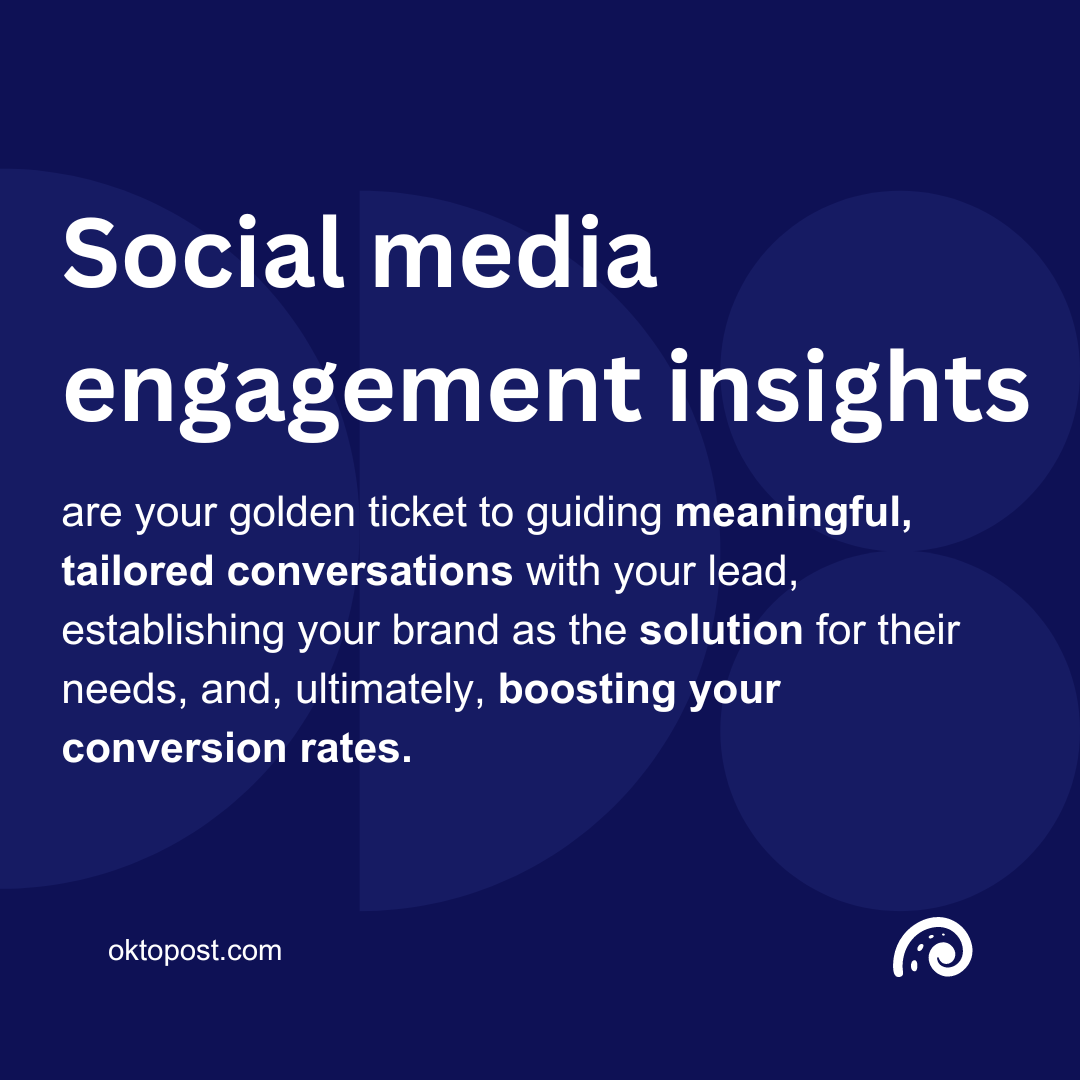Social media marketing managers and sales executives are no longer sitting on opposite ends of the strategy table. To close more deals, sales executives are starting to take social media for sales seriously.
The B2B sales space is changing. In case you haven’t heard yet – building relationships and engaging on social media platforms is the future of B2B sales. Statistics show that 92% of B2B buyers are willing to engage with sales professionals known as thought leaders on social media platforms.
What’s the difference between thought leadership on social media vs. a cold email with similar content? A social media presence builds trust, humanizes you, and establishes your credibility and authenticity. And most importantly, it gives people a reason to listen to you. All these factors beat coming across as a spammer any day.
Why is social media for sales a must-have? Here are some actionable tips to get you onboard.
If you can’t wait and need to jump ahead…
Long gone are the days of sales teams viewing social media as a nice-to-have marketing tool. And if you still are, it’s time to pay attention.
Effectively using social media can make all the difference when meeting (and exceeding) your sales quotas across your sales team.
We’re sure you already felt the shift in B2B buyer behavior. Since buyers have turned away from conversations with sales representatives, cold calls have become spam, and trying to connect when prospecting has been challenging for sales teams to build meaningful relationships with prospects. We are also aware that prospecting emails are rarely opened so your message hardly comes across to your audience.
The best way to get their attention is to find them where they are, online – social media. In fact, 75% of B2B buyers are using social media to research solutions, and sales teams can use social media platforms to engage with them online. The main platform for professionals, of course, is through LinkedIn.
In fact, 56% of sales reps use social media to find new prospects. Trading traditional business cards for an optimized social media profile is a must – networking has gone online now and so should your team. Even after participating in an industry event and starting a conversation with a potential client, you will likely ask to connect on LinkedIn and follow up with them after the event, on LinkedIn.
Top use cases for sales teams to harness social media
Here are the top three use cases for effectively using social media for sales:
Direct interaction with buyers
Social media platforms enable sales teams to interact directly with their target audience. A comment, repost, or like to a potential customer’s post, goes a long way when compared to a cold email. After all, this personalized interaction that humanizes your persona beats a cold email. Statistics show that only 24% of sales emails are opened, and the average cold email response rate is just 8.5%.
Social media allows for direct interactions with prospects in real-time. Whether it’s responding to comments, participating in discussions, or connecting with your target audience on LinkedIn, this direct engagement facilitates building stronger relationships and trust with potential customers that traditional methods can’t offer.
If you see a prospect sharing their opinion on a hot topic in your industry, you can actively join the conversation online and help them solve their challenges. This will make you part of their audience and showcase your professional brand before opting for a hard sell.
Hot tip:
- Search relevant industry topics and start engaging in active discussions on LinkedIn by sharing your expertise on the subject matter.
Social selling
Social selling is a sales strategy focused on building meaningful relationships and establishing trust with potential customers on personal social networks. Social selling involves sales professionals sharing educational content that positions themselves as thought leaders in their industry. But, it’s important to provide value to your audience, not just post what you want them to see.

Here’s how it can help your team close more deals:
- Increased reach and visibility: Professionals prefer to follow industry experts over corporate profiles. This will help you broaden your influence and reach a wider audience of potential customers.
- Nurture existing prospects: While your prospect is deciding on your product and exploring other options, you can keep them engaged and nurtured with the value your company offers through informative content that educates them on their industry.
- Insight into audience preferences: Social media allows sales teams to see their audience preferences, challenges, and desires, allowing you to better understand their needs and tailor your content to resonate with your audience.
- Building credibility as a thought leader: Sharing insightful content and participating in industry conversations on social media can build credibility as a thought leader, attracting more prospects and opening up new sales opportunities.
- Expand your pipeline: Through social selling, you’ll also attract potential buyers who might not be actively seeking services when they follow your profile, thereby establishing a foundation for future conversions.
Hot tips:
- Update your professional title, bio, and profile picture to ensure they’re current. A relevant and professional profile attracts more connections and trust from potential customers.
- Provide value by sharing one of the latest industry-related articles while inserting your unique insights and expertise. To build up your profile, we recommend posting once per day.
Using social intent data to guide prospects further down the funnel
Social intent data might be a relatively new term, but it’s one you’ll want to take action on. B2B sales cycles are already long, and social intent data is the key to moving these buying processes along a little bit faster.
Social intent data refers to information gathered from social media platforms that indicates a user’s potential interest or intent to purchase. This data is collected through their interactions, such as likes, shares, and comments, which can provide valuable insights into consumer behavior and preferences.
When used effectively, the data you can get from social media holds the information you need to convert more leads into customers.
By understanding which topics your leads or prospects are engaging with, you can guide more meaningful conversations that resonate with your buyer’s needs. It’s a not-so-creepy method of knowing what your buyer wants to hear without reading their mind. This way, you can guide them further down the funnel and toward making a purchase.

Sales teams can also leverage social intent data to enhance ABM (Account-Based Marketing) and ABX (Account-Based Experience) strategies by using insights from social media interactions to target high-value accounts with precision.
This data informs personalized communications tailored to the specific interests and needs of each account, ensuring messages are timely and relevant. It can also help your team address real-time concerns of potential customers, enhancing engagement and conversion rates.
By continuously analyzing social intent data, your team can refine their approaches, making adjustments to improve effectiveness and build stronger, more productive relationships with key accounts. This strategic use of social intent data not only optimizes resource allocation but also significantly boosts the overall customer experience, fostering loyalty and driving sales conversions.
Hot tips:
- Go through your posts on social media and make a note of prospect interactions. If you have a scheduled demo or meeting with your prospect, you can use the insights social intent data reveals to strike up a conversation that is relevant to them.
- As well as this, instead of sending the same old “circling back to check if you’re still interested” email, you can send them relevant content or information on a topic you know is something they are interested in learning more about.
Ready to start converting more prospects with social media?
Social media unlocks so many opportunities for your sales team to meet and exceed their sales quotas.
Whether it’s by engaging with your target audience online, building your persona as an industry thought leader with social selling, or truly understanding your buyer’s needs and desires through social intent data, it’s now non-negotiable to leave out of your sales strategy.
With Oktopost, you can turn your sales teams into thought leaders, strengthen their personal brand, and get social intent data signals from prospects delivered straight to your inbox. Learn more about how you can use social media for sales today.


![Read more about the article [Funding alert] Captain Fresh raises $50M in Series C round](https://blog.digitalsevaa.com/wp-content/uploads/2022/03/Imagexozz-1645622979598-300x150.jpg)







